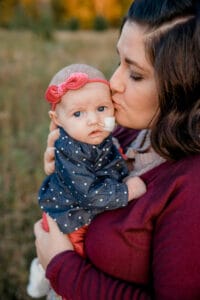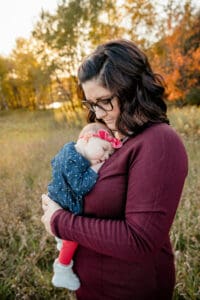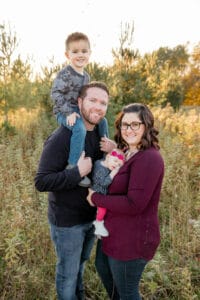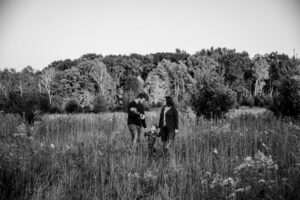
Megan and Jon were told it would be at least six to 12 weeks before they would be able to take their daughter home from the hospital. But Elena had other ideas.
“Elena is doing very well,” said Megan. “Nurses said she was trying to set records.”
“We know families who have been here for six months,” Jon said.
“We are very fortunate,” said Megan.
At their 20-week ultrasound, Jon and Megan found out that their daughter was missing part of her diaphragm. The ultrasound also revealed Elena’s stomach was pushed up into her chest cavity, shifting her heart to the right. When the doctor came in to discuss the ultrasound results, she told them that their baby has a serious birth defect known as congenital diaphragmatic hernia. This is a condition in which part or all of the diaphragm does not form. In Elena’s case, there was a large hole allowing abdominal organs to migrate into the chest cavity, which in turn inhibits lung growth and development.

“It was very scary,” Megan said. “It felt like a death sentence. When we learned how severe it was and read about survival rates…we were very deflated.”
Jon and Megan made a thoughtful, but difficult decision to pursue fetoscopic endoluminal tracheal occlusion (FETO)—a procedure in which a balloon is inserted into the trachea of the fetus and inflated to block the trachea. The procedure forces fluid into the lungs of the fetus helping them to grow and mature. This procedure is still rather investigational and has significant risks: uterine rupture, fetal death, infection, operative complications, early labor, and potential failure. The balloon is to be left in place for several weeks and candidates must stay within minutes of Mayo Clinic during this time period to be closely monitored and in the event of an emergency. There was also no guarantee that they would be candidates for the procedure.
Many tests later—including many ultrasounds, MRI, an amniocentesis, echocardiogram, among others—Jon and Megan were informed their baby was a candidate for the procedure.
FETO is performed in very few locations across the United States, as hospitals and clinics need FDA approval, and it is only performed in the most severe cases of CDH. The deciding factor for Megan and Jon: Mayo Clinic has a doctor who has been performing the procedure for decades across the world and has experienced great success.
The procedure would once again prove successful.
Elena was born without much complication, but she required immediate intubation and respiratory support in the two days leading up to her hernia repair surgery. She had a very severe hernia that they assumed would require a patch to close. Doctors also indicated that her diaphragm would never function as a diaphragm, but that the patch would be used to keep her abdominal organs from coming up into her chest cavity once again. They wouldn’t know the extent until they made the incision.

“I was very nervous,” Megan said. “They were going to cut open my little baby. Surgery is always a risk. There was a very real possibility that I would never see my baby again.
“It was pretty traumatic.”
But the surgeon was pleasantly surprised. They were able to move Elena’s organs into their correct places and were able to use her diaphragm tissue to close the hernia.
“It was amazing,” Jon said. “Simply amazing.”
The surgeon said Elena did very well, but warned that things may get worse before they get better. But Elena didn’t waiver and continually amazed doctors and defied the odds. There is a chance it will herniate again and she may need another surgery. But recovery is going very well.
Elena does not have any heart abnormalities. Initially she was diagnosed with pulmonary hypertension, but that has since subsided.
Every congenital diaphragmatic hernia case is variable and doctors need to be ready for a variety or potential problems but little intervention was needed as Elena exceeded expectations.
Doctors told Jon and Megan that Elena would have been in a very different state without this procedure.

“We are so lucky,” said Megan. “The doctors and nurses are incredible—they have become our family. We are very confident in the care Elena has received.
“We are so fortunate to live near a world-class facility like Mayo.”
After arriving in Rochester for the procedure, Mayo Clinic social workers recommended Megan and Jon call the Ronald McDonald House. They knew about the House, but they did not know if they would be able to stay because their child was not yet born. They learned that parents receiving care at Mayo for fetal surgery and high risk pregnancy are able to stay at the House.
The family was 43rd on the waiting list and waited 12 days for a room—an issue the House hopes is reduced with its expansion. Because Megan and Jon did not have enough money for an extended stay in a hotel, the family contemplated staying in a small camper until there was a room at the House, which would not have been the most comfortable living arrangement at 30 weeks pregnant.
“More rooms and less of a wait time is huge,” Megan said. “I honestly don’t know what we would have done without the House.”
And with their two-year-old son Robbie roaming the halls, the House truly became a home away from home and a refuge after long days and weeks. Extended family members visited and looked after their son while Jon and Megan were with their daughter in the hospital and the House activities made it easy to spend time together as a family.

“Robbie loves the House,” said Megan. “He has made so many friends.”
“I couldn’t imagine being cooped up in a hotel room for all this time,” Jon said.
The support from other guest families is what meant the most to Megan. They felt very fortunate to be able to bond with other families in similar situations as theirs.
In addition to the other children and families, the House is made a home by the hundreds of volunteers who donate their time.
“You come in and the volunteers know you by name and they know your story,” said Megan. “They want to be here. They truly love what they’re doing.”
And the House is fresh off of its capital campaign, which raised more than $17 million and received more than 1,600 unique gifts to add more guest rooms and community spaces.
“So many people who donate to the House or volunteer here will never even use this facility,” Jon said. “It’s incredible…”

Elena did end up setting records, as she went home with her parents after only four weeks, which was several weeks ahead of the original timeline.
“I don’t know if we would have felt like this journey was possible without the Ronald McDonald House,” said Megan. “We would have tried, but it would have been so much harder.”
“We wouldn’t have been able to have the life-saving procedure for our baby without the House,” Jon said.
“It’s more than we could have ever imagined,” Megan said.
“And now it feels like…I can’t even put it into words…it feels like our home,” said Jon.




